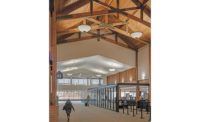Although the COVID-19 pandemic continues to weigh on subcontractors across the Southwest region, industry leaders sound optimistic about the future.
Before the pandemic struck, the region’s specialty firms were building upon a solid performance in 2019. The 30 largest firms in ENR Southwest’s 2020 Top Specialty Contractors ranking reported $2.23 billion in combined regional revenue during 2019, compared with $1.89 billion in 2018.
Rosendin Electric, Tempe, Ariz., earned $176.52 million in 2019, up from $160.55 million during 2018. The firm has fared well during the pandemic, says Brandon Stephens, division manager.
“Fortunately, most of our customers were already underway on the majority of their projects, and by and large, things did not slow down due to COVID,” he says. “We have seen a slowdown in certain industry sectors and markets as the pandemic has continued. Still, we have also seen an increase in new work opportunities with customers in the technology space.”
Megaprojects in Las Vegas have been a bright spot for many contractors and subcontractors. Work continues on Resorts World Las Vegas, a $4.3-billion next-generation resort and casino that is 95% complete, says Dieter Klohn, president of Henderson, Nev.-based SME Steel Contractors, one of the subs on the project. The firm posted $177.84 million in regional revenue during 2019, up from $141.45 million in 2018.
Another Vegas megaproject is the $1-billion Circa Resort and Casino (see p. SW22). Despite intense safety and COVID-19 mitigation efforts at the site, the project is on target under a revised schedule and is currently 65% complete, Klohn says.
“As we collaborate with our clients and partners, we are able to find solutions to continue the work in the most productive way. We all share the same goals—to be viable and successful throughout this pandemic,” he says.
SME has taken advantage of the pandemic-induced slowdown to make facility improvements at its miscellaneous metals and ornamental metals locations.
“Our shops in Nevada and Arizona have enjoyed multiple capital improvements, including new laser-cutting machines, precision laser projectors, brake press and plate-roller equipment, in addition to space expansion and improved layout configurations,” he says.
|
Related Link |
Phoenix Area Booming
Meanwhile, Jay Layton, executive vice president for Arizona operations at TDIndustries, Tempe, Ariz., says that “while most of the nation’s construction markets are struggling, the Phoenix region is still growing. Just this past week, an analytics firm claimed that commercial and multifamily projects were up 82% compared with this time last year. Work continues, albeit with more stringent safety and social-distancing policies in place,” he says.
Layton notes that while many companies are expanding, others are focused on improving operations and maintenance. “We’ve seen an uptick in our on-demand service and change-out divisions as well,” he says.
TDIndustries reported regional revenue of $84 million in 2019, up from $69 million in 2018.
“We all share the same goals—to be viable and successful throughout this pandemic.”
– Dieter Klohn, President, SME Steel Contractors
“Our focus has been around design-assist and design-build projects where we can have an influence early in the process and help the owner control costs and project outcomes,” Layton says. “One such project is Chandler Regional Medical Center Tower D, a five-story patient tower, which is scheduled to complete in Q1 of 2021. We are also involved in several projects in the fast-growing 303 corridor in the West Valley, and we continue to be active on projects at ASU.”
Klohn forecasts the remainder of 2020 as being stable and productive despite the new challenges the industry is facing.
The health care, data center, manufacturing and commercial sectors are all growing, Layton adds.
“We’re also seeing a focused effort on last-mile distribution centers for many major online retailers. We think COVID-19 has irreversibly shifted the market in this direction, so we do not anticipate it slowing down anytime soon,” he says.
However, skilled labor shortages remain a concern throughout the Southwest. Layton notes that TDIndustries has partnered with the area’s educational facilities to help address labor needs, but until more students start viewing the trades as a viable career path, the industry will struggle to reach maximum efficiency, Layton says.
Statistically, New Mexico had one of the worst one-month construction job losses in the country from June to July, according to AGC of America. The state was down 5.9%, or 2,900 jobs. Industry jobs in Nevada declined 1.2%, or 1,100 jobs, and Arizona saw the smallest loss in the region, reporting only a 0.1% decline, or 100 jobs lost.
“The labor force was already severely strained, and the pandemic brought on new and unique challenges regarding training and maintaining our workforce,” Rosendin’s Stephens observes. “The Southwest has always been a predominately cost-driven market. How subcontractors manage their labor force will be a deciding factor on how these firms fare financially.”






